Global Forum For Indurstrial Devlopment is SPONSORED BY ICO INDIA
- MP Society Registration (Act. 1973 No. 44) 03/27/01/21857/19 (MSME Forum Established Since-2009)
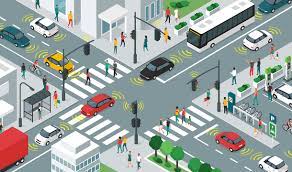
The term connected vehicles refers to applications, services, and technologies that connect a vehicle to its surroundings. A connected vehicle includes the different communication devices (embedded or portable) present in the vehicle, that enable in-car connectivity with other devices present in the vehicle and/or enable connection of the vehicle to external devices, networks, applications, and services. Applications include everything from traffic safety and efficiency, infotainment, parking assistance, roadside assistance, remote diagnostics, and telematics to autonomous self-driving vehicles and global positioning systems (GPS). Typically, vehicles that include interactive advanced driver-assistance systems (ADASs) and cooperative intelligent transport systems (C-ITS) can be regarded as connected. Connected-vehicle safety applications are designed to increase situation awareness and mitigate traffic accidents through vehicle-to-vehicle (V2V) and vehicle-to-infrastructure (V2I) communications.
ADAS technology can be based on vision/camera systems, sensor technology, vehicle data networks, V2V, or V2I systems. Features may include adaptive cruise control, automate braking, incorporate GPS and traffic warnings, connect to smartphones, alert the driver to hazards, and keep the driver aware of what is in the blind spot. V2V communication technology could mitigate traffic collisions and improve traffic congestion by exchanging basic safety information such as location, speed, and direction between vehicles within range of each other. It can supplement active safety features, such as forward collision warning and blind-spot detection. Connected vehicles technologies are also expected to be a fundamental component of automated driving as they will allow the exchange of sensor and awareness data among vehicles, cooperative localization and map updating, as well as facilitate cooperative maneuvers between automated vehicles.
A connected vehicle is one that is capable of connecting over wireless networks to nearby devices. Connected vehicles are an important factor in the advance of IoT. The use cases range from connected entertainment systems that connect with the driver’s mobile phone to Internet-connected vehicles that have bi-directional communication with other vehicles, mobile devices and city intersections.
Connected vehicle is an Internet of Things (IoT) technology with broad implications. As we shared in our blog post, Safety Trends in Traffic Management, connected vehicle technology is part of the Intelligent Transportations Systems government initiative, and there are many active trials around the world today.
One of the primary use cases for the IoT car is safety, via rapid vehicle-to-vehicle and vehicle-to-roadside unit communications (also known as V2X). But there are many other examples of connected vehicle technology at work in the automotive IoT space as well, as we will explore.

According to the US Department of Transportation, “Intelligent Transportation Systems (ITS) apply a variety of technologies to monitor, evaluate, and manage transportation systems to enhance efficiency and safety.” Putting visions of science fiction style transportation aside for the moment, this definition can be simplified into the following concepts for what makes up smart transportation: management, efficiency, and safety. In other words, smart transportation uses new and emerging technologies to make moving around a city more convenient, more cost effective (for both the city and the individual), and safer.
What emerging technologies are facilitating these new opportunities? Primarily the proliferation of IoT devices and 5G communication technology. The former provides for inexpensive sensors and controllers that can be imbedded into nearly any physical machine to be controlled and managed remotely. The latter provides the high speed communications needed for managing and controlling transportation systems in real time with minimal latency.
Smart transportation is not just a theory for the future; it is being implemented today in several cities with their successes and failures being used to improve systems in new locations. Some of the cities that are implementing new transportation technologies may surprise you at first. Of course, global hubs like New York City have embraced smart transportation for their ever increasingly intelligent city. However, the rural state of Wyoming is also a leading testbed for connected vehicles. This is because the cowboy state is a major freight corridor — autonomous transportation of goods across the country can drastically improve supply chain efficiency and reduce the need for long-haul drivers forced to balance tight timelines with their human need for rest.
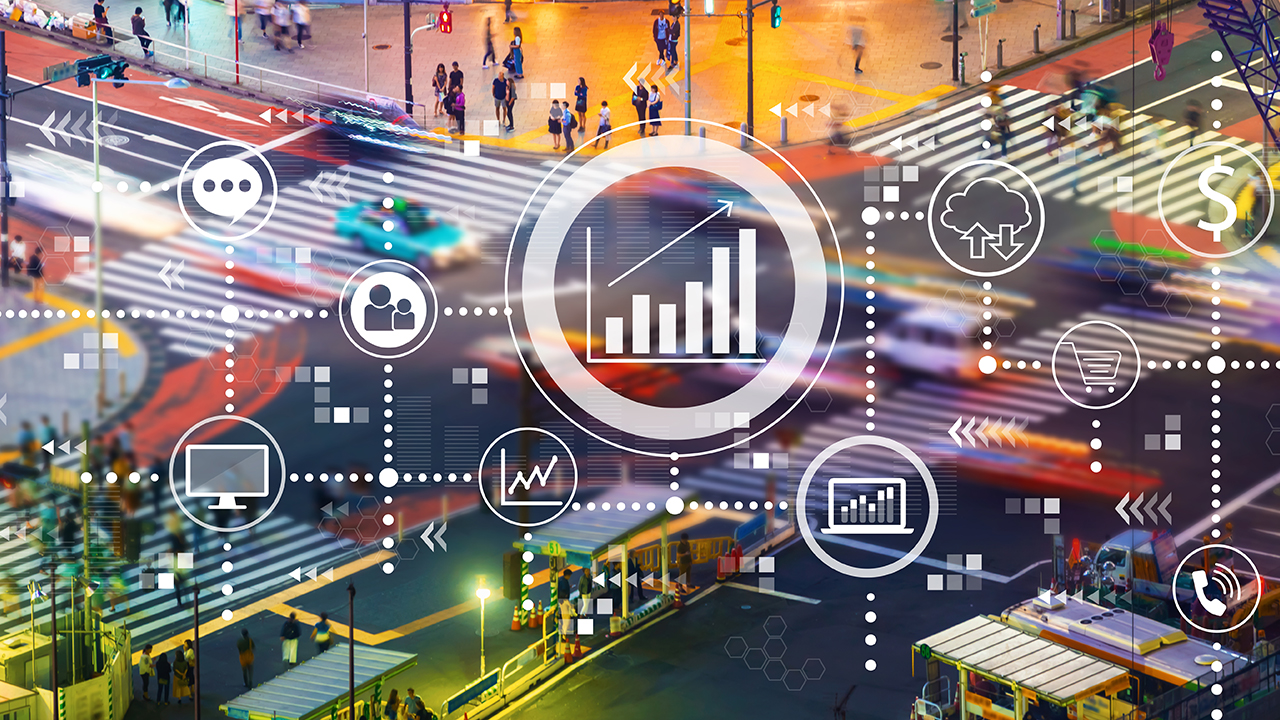
The benefits of smart technology and the advantages they bring to transportation within a smart city are numerous.
By combining machine learning with IoT and 5G, autonomous transportation systems (both in vehicles and in stationary infrastructure such as intersections) have proven to reduce the “human factor” in accidents. Computers don’t get distracted or fatigued or emotional.
Data collection is an important key to responsible public management of infrastructure. Smart transportation not only provides detailed data points for every aspect of the transportation system, but allows administrators to better monitor operations, track maintenance needs, and identify key sources of problems that need to be fixed.
With better management comes more efficient use. Quality data can help to pinpoint areas where efficiency can be improved. Maybe a slight adjustment in train schedules would provide for better fill rates, Or, perhaps bus routes would better serve the community if stops were allocated differently.
Because smart transportation makes better use of the resources available, it can cut down costs thanks to preventative maintenance, lower energy consumption, and fewer resources used towards accidents. Cost savings can also be gained by riders when inexpensive public transit is efficient enough to compete with private vehicle ownership.
City traffic management centers (TMCs) can get rapid visibility and notifications for trouble spots or city-wide issues affecting congestion on city streets, public safety and emergency response systems, in order to take action or communicate more effectively with other agencies and emergency responders.
Beyond the better management, safety, and efficiency already discussed, there are several additional benefits that the general public, local governments, and the world at large can enjoy. These are:
One major fear among smart city skeptics is its vulnerability to cyber attacks. After all, as the world grows more connected, cyber attacks have become nearly commonplace among criminals and even nation states as they target critical infrastructure such as Internet connected power grids and banking systems.
However, the attacks themselves are nothing new—only the tools are novel. Banks, power grids, and other critical infrastructure to include transportation have been vulnerable to physical attacks long before computers have been around. Physical threats such as criminals stealing cars, terrorists using vehicles as weapons (as in the 2016 Lorry attack in France), and bad actors holding public transportation hostage can all be mitigated when vehicles and infrastructure are integrated, networked, and autonomous.
As for the risk of cyber attacks, they are much easier to defend against than the physical threats listed above. Proper software updates, encrypted communications through virtual private network (VPN) tunnels and other multilayered security practices can mitigate the risk of cyber attacks. This means that smart transportation for intelligent cities can make modern public transport safer overall by reducing the opportunities for both physical and cyber attacks.
The history of transportation is inexorably tied to the environment. From steam vehicles that burned coal and wood to today’s gasoline hungry combustion engines, transportation takes a toll on the planet’s resources and atmosphere.
While scientific advances are made every day to find alternative sources of energy to power transportation, another benefit of smart transportation technology is that it allows cities to use their current resources more responsibly.
Mass transit is better for the environment than private vehicles but is not widely used across the US and other countries because it is often impractical in some regions. With the efficiency boosts that come from smart transport solutions, however, modern public transport can be made lucrative for more portions of the population. As urban transportation technology improves in large cities, the proven methods can be replicated and spread to regions that want the benefits of a smart city.
For all their benefits, some disadvantages may come to the surface as smart city transportation systems are implemented. These problems center mainly around power consumption and responsible data management.
Smart cities require sensors — a lot of sensors — and those sensors all require power. For sensors attached to moving objects, this will require batteries. Stationary sensors may be able to use solar power, but more often than not will need to be wired into the city’s electrical grid. The sheer number of sensors required for the world to transition to smart cities (estimated in the trillions) makes powering so many devices a daunting problem. Even for sensors wired into the power grid, the amount of raw material necessary (such as copper) is significantly high compared to what the world population is accustomed to producing.
Beyond power, there is significant debate in the world today regarding personal data online. Data is the lifeblood that smart cities need in order to operate. While much of the information needed is anonymous compared to online data, this will require a mental and behavioral shift among populations. Cars will need to collect positional information and sensors around a city will need to passively collect the signals that a smart phone emits throughout the day. Responsible laws and policies for managing data, no matter how anonymous, will need to be enacted in order for smart cities to thrive into the future.
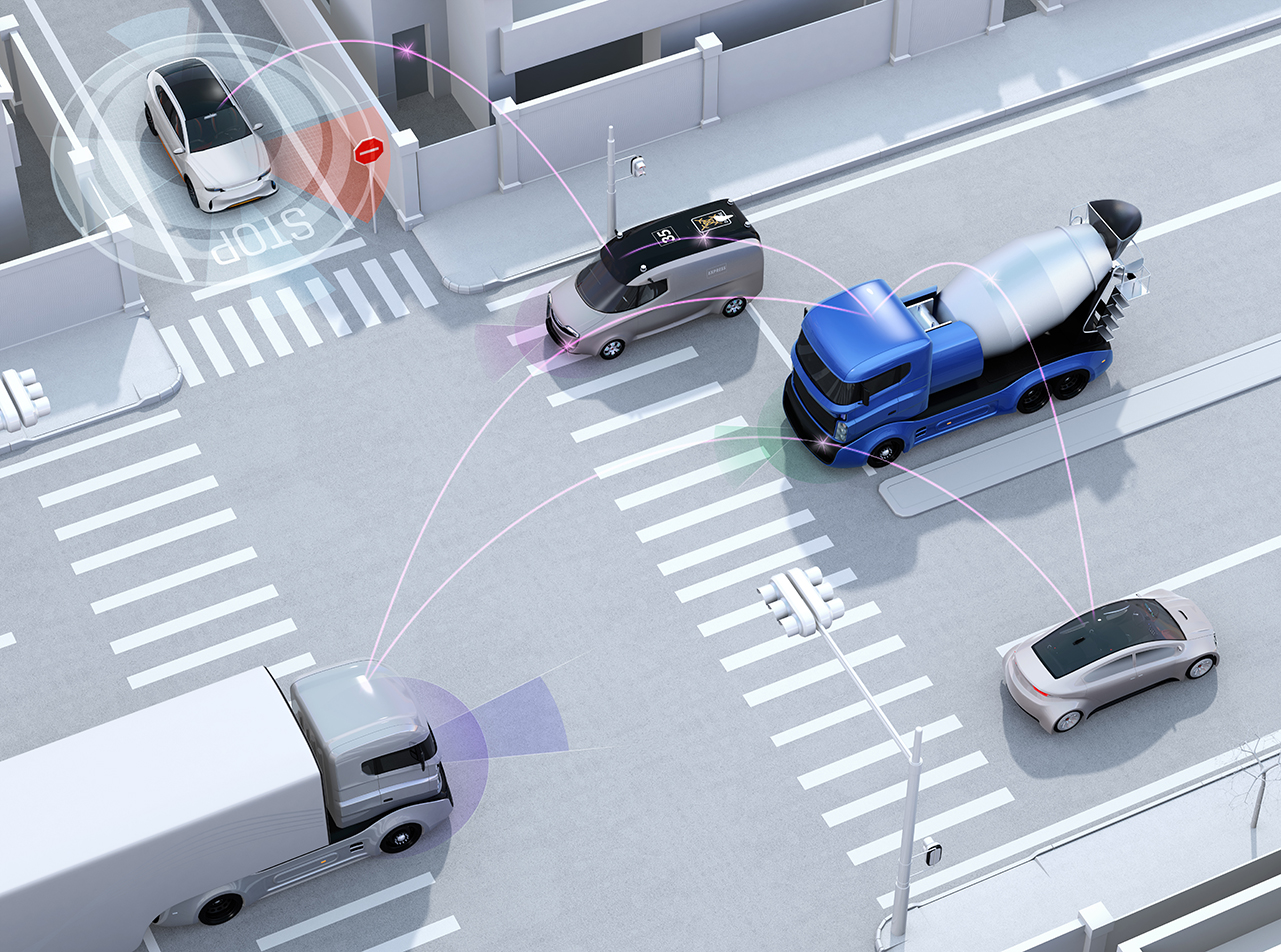
Smart transportation can generally be divided into two broad categories, public infrastructure and the automotive industry. These two sectors become “smart” when networked sensors are integrated into infrastructure and vehicles in an effort to accomplish the goals of remote management and control, safety, and efficiency.
Picture a busy city intersection. Pedestrians are trying to cross. The streetlights are regulating flow of traffic. Drivers in vehicles are busily trying to get to their destination. In traditional transportation systems, the streetlights are triggered either through timers, pressure plates underneath the road, or pedestrian buttons on the curb.
Both the drivers and the pedestrians are responsible for paying attention to (and following) the traffic signals. If any of these nodes fail, however, both efficiency and safety drop. A distracted driver runs a red light. A pedestrian fails to push the crosswalk button, thus missing their turn and having to wait longer. The streetlight refuses to change despite the fact that there is only one car waiting and no traffic.
In a smart intersection, however, this all changes. A vehicle may use a combination of bluetooth and LIDAR (Light Detection and Ranging) to detect pedestrians and can automatically begin breaking to avoid an accident. Streetlights can pick up the individual signals sent from vehicles to determine how many cars are waiting and in which direction far more accurately and efficiently than pressure plates and timers. Cars and streetlights can even communicate to the level that, when the light turns green (or sends the “go” signal to the car’s computer), the car automatically begins moving, and when turning red (or sending a “stop” signal), the car slows down and stops. This is all made possible thanks to the application of technology in transportation such as IoT and 5G communication speeds for real time actions and remote sensing.
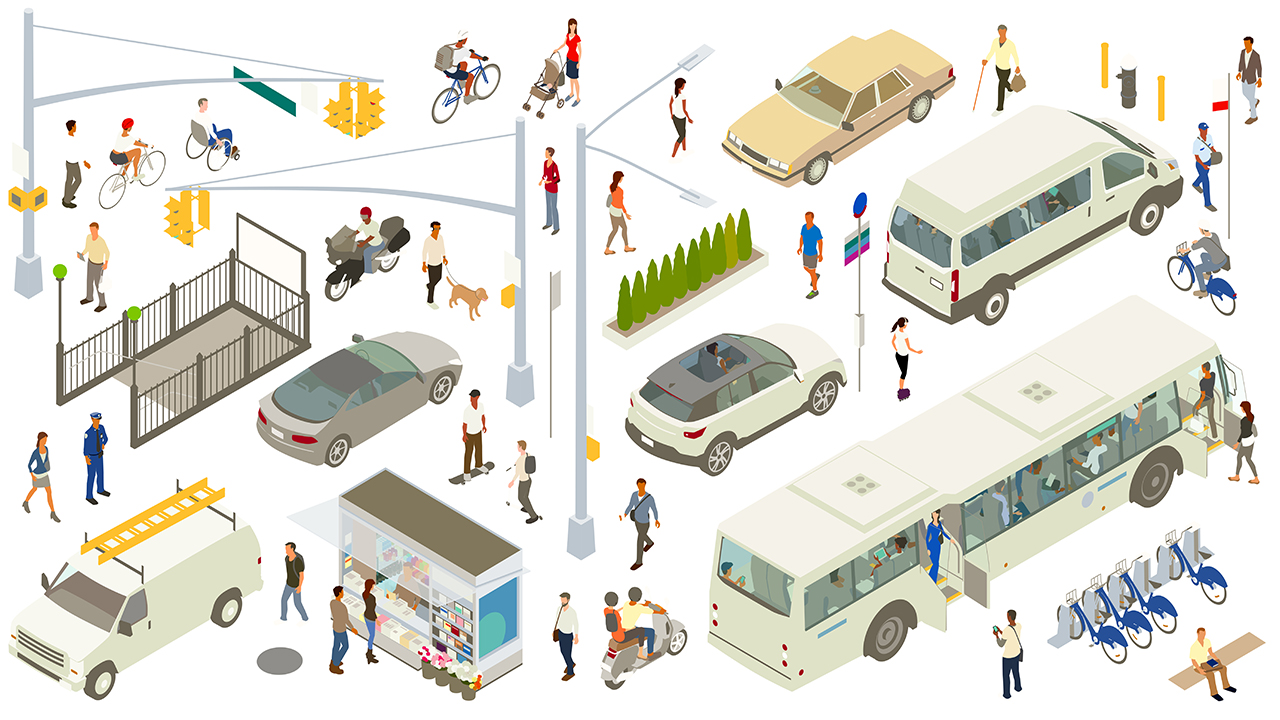
Regardless of the advantages and disadvantages of smart cities, the technology is here and being used today. Across the US and the world, smart sensors and controllers are being implemented in train networks, passenger information systems, and public transport dispatch. Here are some smart city transportation examples:
Miami Dade smart traffic management
Southern Pennsylvania Transportation Authority (SEPTA) Positive Train Control (PTC)
Suburban Mobility Authority for Rapid Transit (SMART) Dispatch System
Miami Dade Advanced Traffic Management System
The county of Miami Dade is the most populated county in Florida, with a population of over 2.5 million residents. Managing the flow of traffic across urban area that makes up the city of Miami and its surrounding areas, including the operation of over 2,700 signalized intersections, is the responsibility of the County of Miami Dade. In fact, the number of signalized intersections and mid-block crossings, is increasing by dozens every year, according to their Traffic Management website.
The Miami Dade Advanced Traffic Management System (ATMS), which includes Digi 4G LTE cellular routers as part of the communications infrastructure in county-wide traffic cabinets, is designed to reduce congestion and delays and improve mobility, county-wide.
SEPTA PTC
SEPTA (Southeastern Pennsylvania Transportation Authority) manages the light rail, subway, and bus services for Philadelphia. With over one million riders daily, these services need to be reliable and safe each and every time a vehicle departs. This is why SEPTA built a positive train control system (PTC) to signal trains, prevent derailments and crashes, and monitor speed and signal violations.
SEPTA accomplishes this with the Digi WR44-RR mobile access router. When integrated onto a train, this device allows for remote communications with wayside sensors over a radio link. The device sends signals with train movement data while receiving information regarding closures and other factors that would necessitate a change in plan. This keeps trains from chugging forward into a dangerous situation.
SMART Dispatch System
Public transport in smart cities is a key area for advancement in connected technologies. In Detroit, SMART (Suburban Mobility Authority for Rapid Transit Authority) manages and dispatches over 300 buses across the city. As an integral part of how the population gets around, it is important for these buses to be on time, safe, and breakdown free. To manage the dispatch and location tracking of buses, the city used an analog radio network with three radio towers scattered around the city.
When it was time for an upgrade, they utilized the Digi WR44 R mobile cellular router. This switch from analog to digital allowed for significantly better management and tracking. The new technology allowed SMART to not only see each vehicle’s location, but also view their speed and monitor maintenance data for each bus. This allowed for better dispatching if a bus started to run behind schedule as well as preventative maintenance to mitigate breakdowns and major repairs, saving them an estimated $70,000 per year.
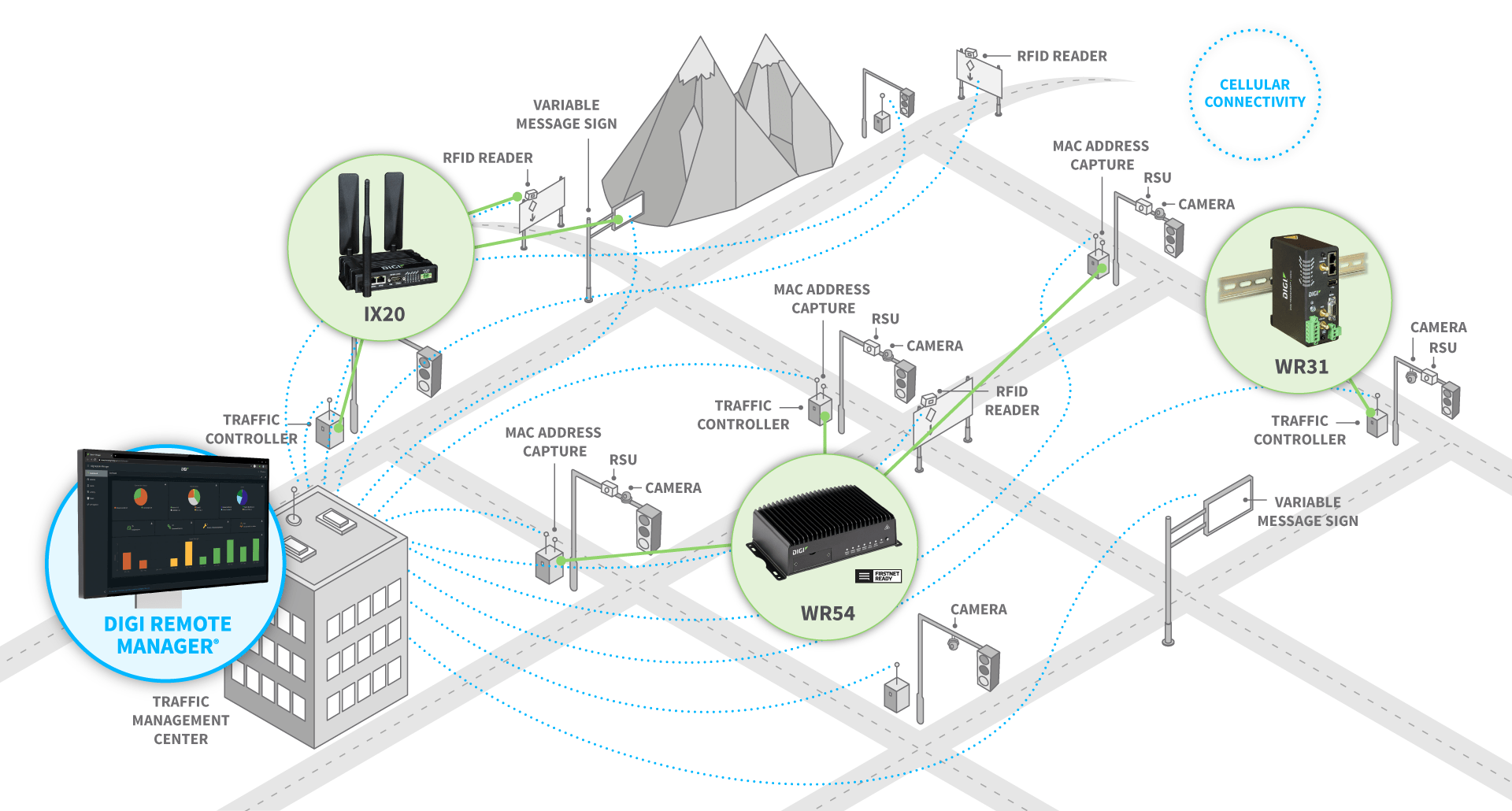
Digi is supporting the rollout of intelligent transportation and connected vehicle systems across the U.S. and the globe, with high-performance, industrial-grade cellular routers - including FirstNet®
Ready systems for priority and pre-emptive communications.
The smart transportation market is highly promising for society. As intelligent transportation systems for smart cities grow in use around the world, populations can begin to reap the many safety, efficiency, and cost benefits that come with modern public transport. It is exciting to think about how society might interact with their cities with the latest technologies that are becoming available today.
To see more benefits and examples of how Digi’s smart transportation IoT solutions can move society forward, visit our Traffic Management page, or contact us today to start the conversation.